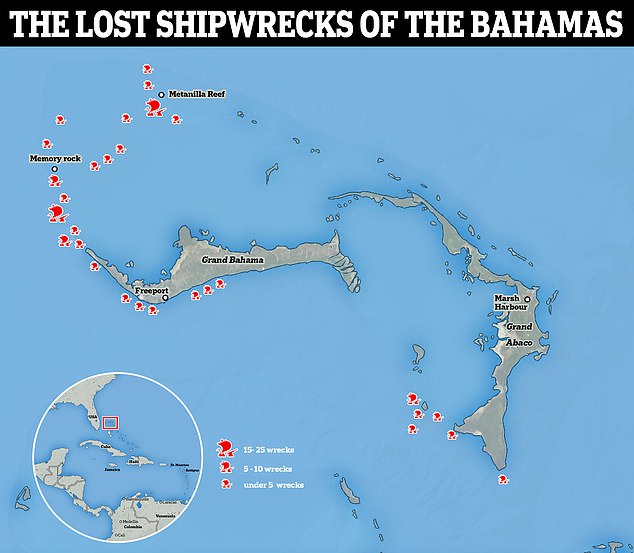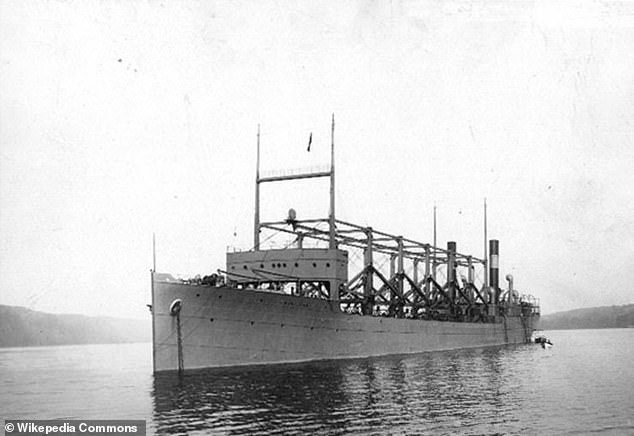An expert has blow the lid on the mystery of the Bermuda Triangle after generations have been haunted by rumors about the notorious region.
Monster ‘rogue waves’ in the Bermuda Triangle formed in ‘perfect storm’ conditions could be responsible for swallowing long-vanished ships and crews, according to an oceanographer who has studied the area for years.
Dr Simon Boxall, of the University of Southampton, said ‘rogue waves’ first discovered in the mid-1990s are the likely culprit behind the mystery of the Bermuda Triangle, located between Florida, Puerto Rico and Bermuda.
Rogue waves are enormous crests of water that can measure up to 100 feet tall.
If two follow in quick succession a ship can find itself suspended between them – one wave at its bow, another at its stern. That can then cause a ship to snap in half because there is no buoyant water to support the weight of its center section.
The Bermuda Triangle has seen myriad famed and previously unexplained phenomena, from disappearing planes flying through the area to vessels that have sent out distress signals before immediately vanishing from the face of the Earth, since the early 20th century.
Many theorists have posited supernatural, alien and other explanations in the intervening years, but Boxall told the Daily Mail the area’s reputation can fundamentally be explained by science.
‘You get two or three storms coming together and, what happens is, the waves from different storms interact,’ he said. ‘The biggest waves you get from a single storm are usually about 10 meters, 12 meters tops – which [is] very big, but not sort of horrendous big.
‘Then, the same way as you usually get these beat frequencies, you get the same thing with water waves. And so, if you get two troughs that happen to occur at the same time, or two peaks at the same time, they catch up.


Dr Simon Boxall, an oceanographer at the University of Southampton, says the enduring Bermuda Triangle mysteries can be solved by science and rational explanations
‘So you end up with, rather than a 10-meter wave, a 20-meter wave. If you get three different wave systems coming together, you can get a 30-meter wave, but they also cancel out. So you get this sort of beat pattern… sort of a few low waves and some big waves and so on.’
Boxall said when those big waves come together, there are even bigger ones that form as a result and do not behave like normal waves.

Dr Simon Boxall (pictured), an oceanographer at the University of Southampton, said rogue waves are uncommon but satellite surveillance is helping researchers learn about them
He compared it to splashing in a bathtub.
‘You splash around in the bath, and you sort of bring a couple of waves together in the bath, you get that sort of big plop coming up from the bath which goes down again,’ he said. ‘And that is effectively rogue waves.’
If a ship – particularly a large vessel – is in the water when rogue waves form, it can face certain doom.
‘Something like a supertanker or a big cargo vessel’ that is around 400 meters long can be destroyed by a 30-meter wave, he said.
‘The distance between the peaks is maybe only, let’s say, 200, 300 meters. So you’ve got a boat being suspended, one end by the front of the wave, the other back end by the back of the wave – in the middle, there’s nothing,’ he said. ‘So the boat breaks in two.’
Rogue waves are nearly impossible to measure, but Boxall said satellite technology is helping researchers pinpoint when they occur.
Rogue waves, though, have hardly been responsible for all Bermuda Triangle mysteries, according to Boxall. He credits the majority of losses to weather, human error and inexperience.

Larger ships, such the USS Cyclops (pictured), would be particularly susceptible to being broken and sunk by ‘rogue waves’, according to the oceanographer
Most mariners – or pilots, for that matter – wouldn’t be out in the stormy conditions that cause rogue waves, which don not ‘come out of the blue’.
‘It’s not like a rogue wave or something appears from a calm sea. It’s not like some sort of Poseidon Adventure,’ he said referencing the 1970s disaster movie.
Boxall argues that, even for flights that disappeared in the region, there are rational and scientific explanations.
He points to the 1945 disappearance of Navy bombers on a training flight and the subsequent loss of the rescue plane, which for nearly a century has stood as a prime example of the Bermuda Triangle’s terrifying mystery to many theorists.
‘The evidence is actually very different,’ Boxall said. ‘The person in charge of the training flight was renowned for being a bit of an a*** and wouldn’t ever listen to anyone. He misread the land. He misread where he was.
Now there’s actually evidence to show that one of the towers picked up a radio messaging between him and his students… saying, ‘We think we’re going the wrong way, sir.’
‘The story is that you’ve got this experienced flight going out, so there must be something weird going on… the reality is they weren’t [experienced].’
Boxall said most academics and scientists ‘ignore’ the Bermuda Triangle because ‘there’s nothing there’ – and that the myths persist because of a fascination by the public.
He said he has received blowback from some Bermuda Triangle enthusiasts for his ‘rogue wave’ and rational explanations.
‘People will ignore facts and figures all the time,’ he said. ‘We have real problems in trying to persuade people once they’re determined.’
